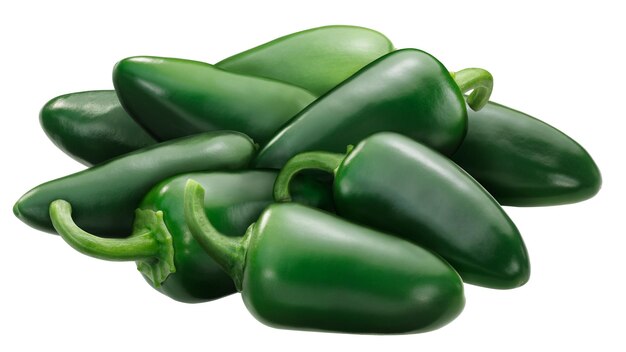Jalapeno capsicum, also known as Capsicum annuum, is a popular variety of chili pepper known for its vibrant green color, moderate heat, and rich flavor. This versatile pepper, widely used in a variety of cuisines, particularly Mexican, American, and even in some Asian dishes, is not just a flavorful addition to food but also a source of numerous health benefits. Whether you are an amateur cook or a seasoned chef, understanding the jalapeno capsicum can enhance your culinary experiences and even contribute to your overall well-being.
In this article, we will explore the nutritional benefits, culinary uses, and various types of jalapenos, as well as how to grow and preserve them. We will also provide a helpful comparison chart to help you differentiate jalapenos from other chili peppers, ensuring you pick the right one for your dish. Let’s dive in!
What is Jalapeno Capsicum?
Jalapeno capsicum refers to the well-known jalapeno chili pepper, which belongs to the Capsicum annuum species. Native to Mexico, jalapenos are often categorized as mild-to-medium heat peppers, ranging between 3,500 and 8,000 Scoville Heat Units (SHU). They are one of the most popular chili peppers used globally, owing to their combination of heat and flavor, making them a staple in salsas, salads, and even stuffed or grilled.
Jalapenos can be eaten raw, pickled, or roasted, and they serve as a perfect balance between spiciness and the ability to complement a variety of other ingredients. While they are commonly used in hot sauces, their subtle heat can be tamed by removing the seeds and membranes, making them a perfect addition for people who prefer milder spice.
Health Benefits of Jalapeno Capsicum
Jalapenos are not only known for their spicy kick but also for their health-promoting properties. Here are some of the key benefits that make jalapenos a great addition to your diet:
Rich in Vitamins and Antioxidants
- Jalapenos are packed with vitamins A, C, and K, making them a powerful source of antioxidants. Vitamin C, in particular, helps boost the immune system, while vitamin A supports good vision and skin health.
- They also contain a decent amount of folate, which is beneficial for cell growth and preventing neural tube defects during pregnancy.
Boosts Metabolism
- Capsaicin, the compound that gives jalapenos their heat, is well-known for boosting metabolism. Studies suggest that capsaicin can help increase the rate at which the body burns calories, which may aid in weight management.
Improves Digestion
- The capsaicin in jalapenos can also promote healthy digestion. It stimulates the production of digestive enzymes and helps improve blood circulation to the stomach, reducing symptoms of indigestion.
Pain Relief
- Capsaicin has been shown to have pain-relieving properties. It is often used in topical creams to relieve muscle and joint pain, as it can help block the transmission of pain signals.
Supports Heart Health
- Jalapenos, like other chili peppers, contain compounds that can help lower blood pressure and improve cardiovascular health. Capsaicin helps dilate blood vessels, which improves blood flow and may reduce the risk of heart disease.
Culinary Uses of Jalapeno Capsicum
Jalapenos are incredibly versatile and can be used in many different ways to enhance the flavor of your dishes. Here are some common ways to incorporate jalapeno capsicum into your meals:
Fresh and Raw
- Sliced or diced jalapenos add a spicy crunch to salads, salsas, guacamole, and sandwiches. They can also be used as a garnish for soups, tacos, and even pizza.
Pickled Jalapenos
- Pickling jalapenos is a popular method for preserving them and adding tangy flavor to dishes. Pickled jalapenos are a staple in many Mexican dishes and can be added to tacos, nachos, or eaten as a side dish.
Stuffed Jalapenos
- One of the most popular preparations is stuffing jalapenos with cheese, cream cheese, or a mixture of meats and spices. These stuffed peppers are often wrapped in bacon and grilled, creating a delicious, smoky flavor.
Roasted or Grilled
- Roasting or grilling jalapenos brings out their natural sweetness while tempering their heat. This method works particularly well in salsas, sauces, and dips, where the charred skin adds depth of flavor.
Jalapeno Hot Sauce
- Jalapeno peppers are often used to create hot sauces, offering a moderate level of heat while enhancing the overall flavor of the sauce. This is a great addition to eggs, grilled meats, and vegetables.
Jalapeno Poppers
- This dish involves stuffing halved jalapenos with cheese and sometimes meat, then breading and frying them. It’s a popular snack or appetizer at parties and gatherings.
Different Varieties of Jalapeno Capsicum
Jalapenos come in several varieties, each with its own unique flavor, color, and heat level. While the classic green jalapenos are the most common, other types exist to suit different culinary needs.
| Variety | Heat Level (SHU) | Flavor Profile | Description |
| Traditional Green | 3,500 – 8,000 | Tangy, slightly bitter | The classic jalapeno with a moderate heat level and earthy flavor. |
| Red Jalapenos | 4,000 – 10,000 | Slightly sweeter and milder | Ripe jalapenos that have a richer, sweeter flavor and slightly more heat. |
| Jalapeno M | 3,000 – 5,000 | Mild, earthy, slightly grassy | A hybrid variety known for its milder heat and crunchy texture. |
| Stuffing Jalapeno | 2,500 – 5,000 | Mild, sweet | Perfect for stuffing with cheese, meats, or other fillings due to its thick walls and mild heat. |
| Smoked Jalapeno (Chipotle) | 5,000 – 10,000 | Smoky, earthy | Jalapenos that have been dried and smoked, commonly used in Mexican cooking. |
The chart above provides an overview of the most popular varieties of jalapenos, showcasing their heat levels, flavors, and uses. Understanding these differences will help you choose the best jalapeno for your recipes.
How to Grow Jalapeno Capsicum at Home
If you love fresh jalapenos, growing them at home is a great option. Here’s a basic guide to growing your own jalapeno plants:
Choose the Right Location
- Jalapeno plants require full sunlight, so choose a location that receives at least 6 hours of direct sunlight per day. They also need well-draining soil with a slightly acidic to neutral pH (around 6.0-7.0).
Start from Seeds
- You can start jalapeno plants from seeds indoors 8-10 weeks before the last frost date. Plant the seeds in small containers, and keep them in a warm, sunny spot to encourage germination.
Transplant Outdoors
- Once the seedlings have grown strong and the outdoor temperatures are consistently warm, transplant them to your garden. Space the plants about 18 inches apart.
Watering and Care
- Jalapenos need regular watering, but be careful not to overwater, as this can lead to root rot. Mulch around the plants to retain moisture and keep weeds at bay.
Harvesting
- Harvest jalapenos when they reach a size of about 2-3 inches long. For a mild flavor, pick them while they’re still green. If you prefer a sweeter taste, wait until they ripen to a red color.
Preserving Jalapenos
If you find yourself with an abundance of jalapenos, don’t worry! There are several ways to preserve them for later use:
- Freezing:
- Slice or chop jalapenos and place them in a single layer on a baking sheet. Once frozen, transfer the peppers into airtight containers or freezer bags. Frozen jalapenos can be used directly from the freezer in cooking.
- Pickling:
- Pickled jalapenos can be stored in jars for up to a year. The pickling process involves immersing the peppers in a vinegar-based brine with spices.
- Drying:
- You can dry jalapenos by air-drying them, using a dehydrator, or drying them in an oven. Dried jalapenos, also known as chipotles when smoked, can be ground into chili powder or rehydrated for use in sauces and soups.
Conclusion
Jalapeno capsicum is a fascinating and versatile pepper that adds heat and flavor to many dishes. From fresh salsas to smoked chipotles, jalapenos have a place in kitchens worldwide. Their health benefits, including weight loss support, improved digestion, and pain relief, make them a great addition to any diet. Whether you are growing your own, cooking with them, or preserving them for later use, jalapenos continue to shine as a beloved ingredient in kitchens everywhere.
So, next time you reach for that green pepper, consider its full potential. Try exploring the different varieties, incorporate them into new dishes, and enjoy the fiery kick that jalapenos bring to the table!Top of Form







